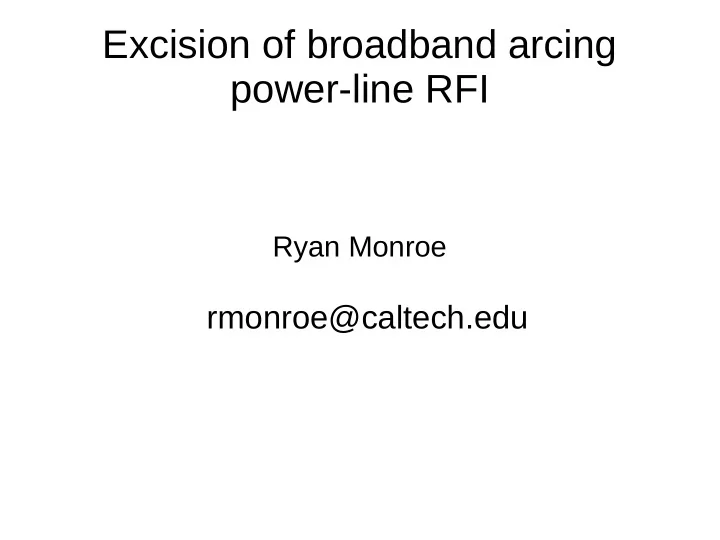

Excision of broadband arcing power-line RFI Ryan Monroe rmonroe@caltech.edu
The Owens Valley Radio Observatory Long Wavelength Array (OVRO-LWA) ● 288 Dual-pol Antennas ● Full sky viewing @ ~25-85 MHz
The Owens Valley Radio Observatory Long Wavelength Array (OVRO-LWA) ● 4 pols* 2400 channels* 33000 baselines = 1.2558e+09 visibility measurements per integration! ● Flagging of RFI and bad data – {antenna, channel, visibility}
RFI seen from OVRO ● Minimal RFI from intentional broadcasters - easily flagged ● However, power-line arcing produces broadband, time- variable RFI ● Fitting for near-field emitters produces candidate sources.
RFI seen from OVRO ● Unlike most RFI, this is on often and broadband – hard to remove with time/frequency flagging
Beamformed detection ● Beamform in the direction of source for detection and analysis ● Easy to see RFI events with integrated power detector
Beamformed detection ● Pulses unresolved at 41.6 microseconds ● Clear 60 Hz trend to pulse groupings
Results ● Flag in time @ 41.6 us, correlate in software
Results ● Easy to implement on GPU correlator; for large arrays is often computationally efficient = real-time processing ● OVRO-LWA will use this for final 352-antenna array
Flagging Bad Data ● Antennas: 288 (easy) ● Frequencies: 2398 (easy) ● Baselines: 165600 (much harder!) – Most baseline-driven issues are stable in time
Baseline flagging ● Insight: visibilities smooth in {u,v,w,time,frequency} ● Instrumental effects violate this
Baseline flagging ● Insight: visibilities smooth in {u,v,w,time,frequency} ● Fit low-order polynomial to surface, look for large residuals
Baseline flagging ● Limitation: require sufficient visibility density – In our case, long baselines too sparse
Baseline flagging ● Discovered: a few bad antennas, frequencies – Also, adjacent ARX line leakage – (was already planning on designing improved ARX boards)
Conclusions ● You might need evidence to convince utilities companies to clean their power lines: look for something like this ● Created realtime RFI mitigator which is easy to implement in software ● Used smoothness assumption in visibility space to flag bad baselines ● Email me at rmonroe@caltech.edu
Recommend
More recommend